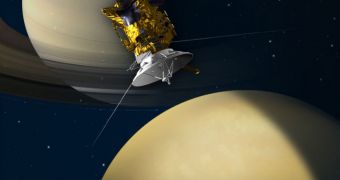This weekend, the NASA/ESA Saturn explorer Cassini did a new flyby around Titan, the gas giant's largest moon, and also one of the most interesting objects in the solar system. The body is believed to be home to a large number of liquid hydrocarbon lakes, most notably methane and ethane. The North Pole contains most such features, with the South Pole believed to host a smaller number of lakes. This is the main reason why the new Cassini flyby was aimed at analyzing the northern parts of the moon in greater detail, experts at the NASA Jet Propulsion Laboratory (JPL) announce.
The space probe flew within 960 kilometers (600 miles) of Titan's surface, closer than during the previous flyby. Its science instruments got the chance to take another peek through what astronomers believed to be fog clouds and onto the surface. The area has been mapped on numerous other occasions by the spacecraft, but astronomers still don't have the complete picture of what goes on on the moon. The last flight, as well as others to come, will continue to add new information to the maps. The goal is to produce a comprehensive view of as much of the surface as possible, experts say.
At the closest point to Titan, Cassini flew at around 82 degrees North latitude. The approach was marked on the evening of December 27 Pacific time (PST), or shortly after midnight Universal Time (UTC) on December 28. The new flight was named T64, but mission managers reveal that planning changes early in Cassini's mission actually make it the 65th flight it did around Titan. The event also marked five years and three days since the Huygens component of the mission was parachuted on the moon, on December 24/25, 2004. The surface was reached on January 14, 2005.
The new flyby “will enable scientists to gather more detail on how the lake-dotted north polar region of Titan changes with the seasons. Scientists will be using high-resolution radar to scan the large and numerous lakes in the north polar region for shape-shifting in size and depth. The ion and neutral mass spectrometer team will take baseline measurements of the atmosphere to compare with the moon's south polar region when Cassini flies by that area on January 12. Cassini will also be collecting images for a mosaic of a bright region called Adiri, where the Huygens probe landed nearly five years ago,” the JPL crew said before the flyby.

 14 DAY TRIAL //
14 DAY TRIAL //